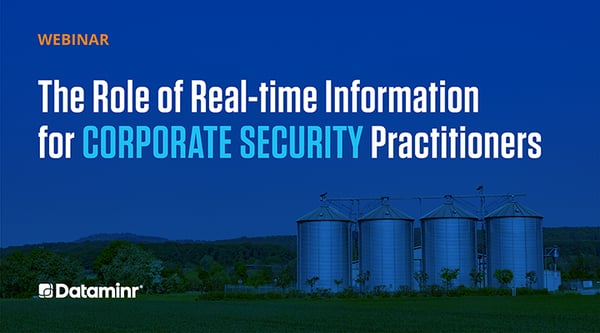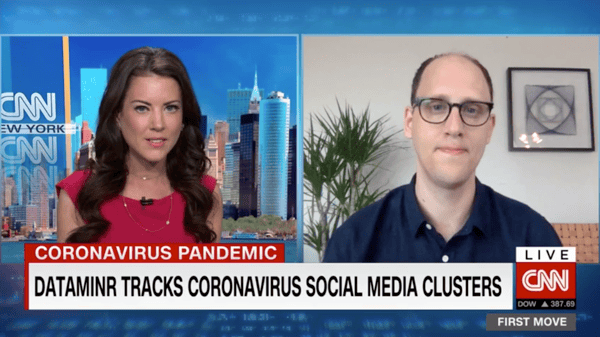"There are often times when I see an event on Dataminr 10 minutes before I see anything about it on Twitter or anywhere else," says TIME Magazine Senior Editor Peter Clark.
Dataminr is an essential digital tool at TIME Magazine, because it delivers early signals to breaking news quickly and efficiently. Read this case study to get an inside look into how TIME uses Dataminr AI in the newsroom.
At TIME magazine, the newsroom never sleeps. Staying on top of the world’s breaking news—and deciding what to cover—is the responsibility of a team of editors, who work with their reporters to craft raw information into timely, accurate stories.
TIME Senior Editor Peter Clark counts Dataminr as an essential part of his toolset because it delivers early signals to breaking news quickly and efficiently.
“There are often times when I see an event on Dataminr 10 minutes before I see anything about it on Twitter or anywhere else,” he said. In a busy newsroom, an advantage like that is invaluable.
Founded in 1923, TIME magazine has remained competitive for nearly a century by consistently adopting emerging newsroom technology.
Dataminr is a leading artificial intelligence platform that analyzes billions of public data points every day to find emerging signals to unexpected events across the globe. The company delivers early alerts to potential breaking news stories to many of the world’s largest news organizations faster than traditional news wires
“I think a big benefit of Dataminr that I have yet to see in another tool is the immediacy and the filter through which things are alerted,” Clark said. Without Dataminr, he says he would have to cobble together a patchwork of other products to create similar news-gathering functionality.
The other big benefit is Dataminr’s high signal-to-noise ratio. Rather than sending journalists like Clark a sea of information to parse through themselves, Dataminr delivers a succinct, actionable picture of major events happening globally.
"There are often times when I see an event on Dataminr 10 minutes before I see anything about it on Twitter or anywhere else" -
Peter Clark, Senior Editor, TIME magazine
“Aggregation is definitely not easy,” he said, “But Dataminr’s aggregation enables it to comb finely through a lot of the nonsense that exists on social media.”
Dataminr is one of the first applications that Clark checks when he opens his browser. A story will often begin with an alert from Dataminr, which delivers the first signal that something is happening.
From there, he uses Dataminr to stay on top of the story as it develops. The ‘track story’ feature, for instance, delivers emerging details in real time as breaking news unfolds, prompted by a single click. This helps him assess a story’s legitimacy while reporters try to get official confirmation from local authorities.
Clark described working one Sunday in late 2019, when he got an alert that people were fleeing a mall in Boca Raton, Florida, and that one person had been injured.
“Report of shots fired,” the Boca Raton police department tweeted within minutes of the initial 911 calls. “One person with gunshot wound transported to Delray Medical Center. SWAT teams grid searching mall. If in mall, shelter in place until officers reach you to evacuate you.”
Clark watched his Dataminr dashboard for eyewitness photos and videos, which people posted publicly to their social media channels as they fled the mall. Within hours, police issued a new statement—it had been a false alarm, and one person had been hospitalized with minor injuries after running into a door.
“Much to Dataminr’s credit, we had... the things that were telling the story,” he said. “It helped us get sort of a breadth and scope of the situation on the ground in a way that was very reassuring.”
The platform also enabled him to track a widespread power outage in Paris
“It was extremely helpful to get these notifications on the web app’s dashboard and through my email inbox, to gather not only the size and the scope of the outage but also the cause,” he said. “It let us judiciously and efficiently decide whether to assign [the story] or not.”
TIME is renowned for its in-depth coverage and readers rely on the publication for fresh perspectives. It excels at highlighting multiple sources during a developing story, to give readers more context.
For example, TIME reporters wrote multiple stories in the wake of the mass shooting at a Walmart in El Paso, Texas, exploring how important that store is to the area’s crossborder community.
“That’s absolutely one of those stories where a platform like Dataminr gave us an understanding that we couldn’t get just from talking to a public information officer or from local news reports,” Clark said. “There’s a humanity, I think, to what Dataminr can provide. It shares what people’s concerns are, not only in the immediacy of an event like that, but in the aftermath.”
There’s another feature of Dataminr that’s especially powerful when dealing with stories that affect multiple communities: translation.
“We get a lot of notifications in different languages and Dataminr provides excellent translations, which are extremely helpful,” Clark said.
Dataminr has become an important part of Clark’s editorial workflow at TIME because he is able to customize it to his own needs. “I would absolutely recommend it just based on my own personal experience,” Clark said. “I’ve been very happy with Dataminr, and I use it pretty extensively. The speed and the high quality of its aggregation is honestly something that I haven’t seen in any other tool.”
Dataminr helps him do his job quickly and accurately by providing rich context and more sources for leads, from ongoing updates to original alerts on breaking stories.
“I feel like Dataminr is very finely tuned to my use case and am happy with the specificity of how I can set it up for my own personal usage,” he said.
"There’s a humanity, I think, to what Dataminr can provide. It shares what people’s concerns are, not only in the immediacy of an event like that, but in the aftermath." -
Peter Clark, Senior Editor, TIME magazine



